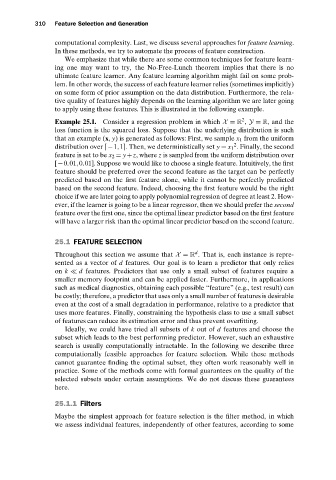Page 328 - Understanding Machine Learning
P. 328
Feature Selection and Generation
310
computational complexity. Last, we discuss several approaches for feature learning.
In these methods, we try to automate the process of feature construction.
We emphasize that while there are some common techniques for feature learn-
ing one may want to try, the No-Free-Lunch theorem implies that there is no
ultimate feature learner. Any feature learning algorithm might fail on some prob-
lem. In other words, the success of each feature learner relies (sometimes implicitly)
on some form of prior assumption on the data distribution. Furthermore, the rela-
tive quality of features highly depends on the learning algorithm we are later going
to apply using these features. This is illustrated in the following example.
2
Example 25.1. Consider a regression problem in which X = R , Y = R,and the
loss function is the squared loss. Suppose that the underlying distribution is such
that an example (x, y) is generated as follows: First, we sample x 1 from the uniform
2
distribution over [−1,1]. Then, we deterministically set y = x 1 . Finally, the second
feature is set to be x 2 = y +z,where z is sampled from the uniform distribution over
[−0.01,0.01]. Suppose we would like to choose a single feature. Intuitively, the first
feature should be preferred over the second feature as the target can be perfectly
predicted based on the first feature alone, while it cannot be perfectly predicted
based on the second feature. Indeed, choosing the first feature would be the right
choice if we are later going to apply polynomial regression of degree at least 2. How-
ever, if the learner is going to be a linear regressor, then we should prefer the second
feature over the first one, since the optimal linear predictor based on the first feature
will have a larger risk than the optimal linear predictor based on the second feature.
25.1 FEATURE SELECTION
d
Throughout this section we assume that X = R . That is, each instance is repre-
sented as a vector of d features. Our goal is to learn a predictor that only relies
on k & d features. Predictors that use only a small subset of features require a
smaller memory footprint and can be applied faster. Furthermore, in applications
such as medical diagnostics, obtaining each possible “feature” (e.g., test result) can
be costly; therefore, a predictor that uses only a small number of features is desirable
even at the cost of a small degradation in performance, relative to a predictor that
uses more features. Finally, constraining the hypothesis class to use a small subset
of features can reduce its estimation error and thus prevent overfitting.
Ideally, we could have tried all subsets of k out of d features and choose the
subset which leads to the best performing predictor. However, such an exhaustive
search is usually computationally intractable. In the following we describe three
computationally feasible approaches for feature selection. While these methods
cannot guarantee finding the optimal subset, they often work reasonably well in
practice. Some of the methods come with formal guarantees on the quality of the
selected subsets under certain assumptions. We do not discuss these guarantees
here.
25.1.1 Filters
Maybe the simplest approach for feature selection is the filter method, in which
we assess individual features, independently of other features, according to some

